Today is Thursday, so it’s not technically a Wheel Gun Wednesday, but I didn’t think fans of our series on defensive revolvers would mind too much.
In late 2015, I attended a couple of defensive revolver training classes. The two classes covered similar technical skills, but were very different in terms of tone and attitude toward the viability of revolvers as self-defense tools in the modern world. I actually happen to agree with both perspectives on this issue. As with many of these kind of “debates”, it all comes down to a matter of context. Details in the video…
In case this whole novel idea of talking pictures on the Internets frightens and scares you, here’s the full transcript:
About a year ago, I started Wheel Gun Wednesdays – they were a series of blog posts and videos about using revolvers for self-defense. I worked on that on and off throughout 2015 and then I was able to kind of cap it off by taking a couple of different revolver training classes back in October and November.
The first was the Revolver Roundup in Dallas, Texas. This two-day class was put on by Darryl Bolke and Wayne Dobbs of Hardwired Tactical. They also invited Chuck Haggard and Claude Werner to help them out. The four of them did a kind of revolver seminar where each guy taught a half day of lecture and rangework on a different topic related to the defensive use of revolvers.
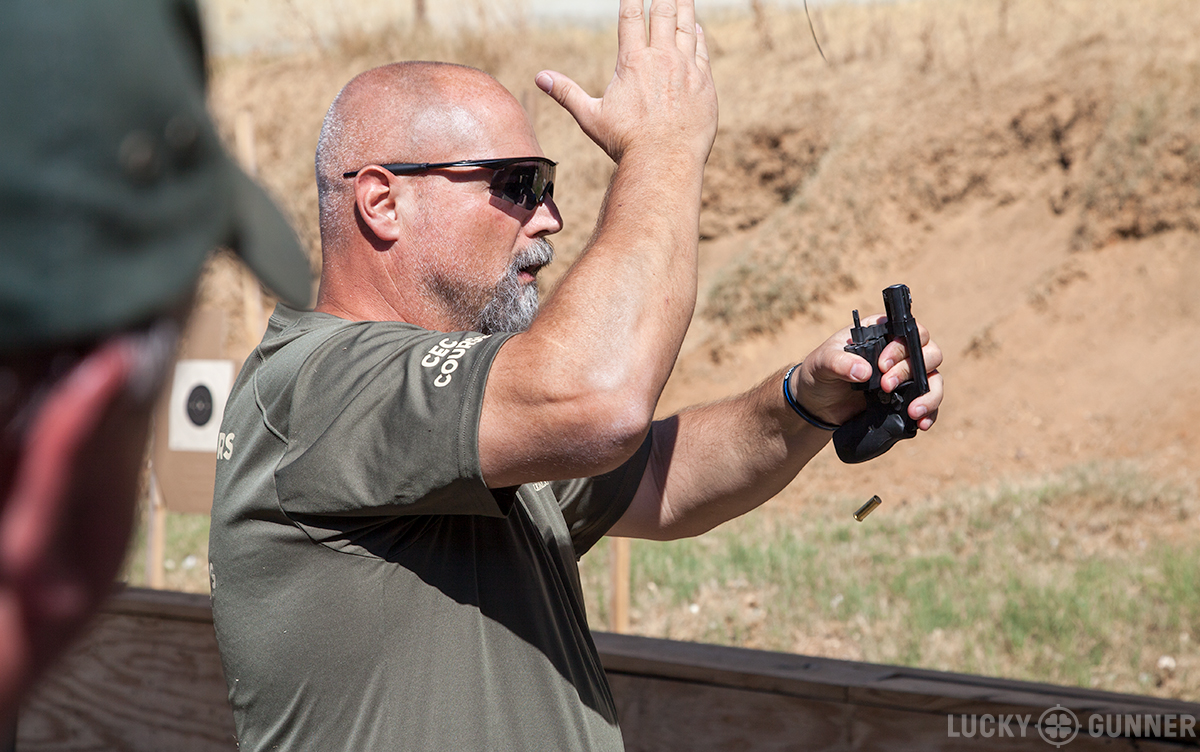
The other class was with Tom Givens. During a November weekend in Franklin, TN, he taught a one day revolver class followed by a one day shotgun class.
Despite having decades of experience teaching people how to use them, Tom is pretty critical of revolvers in general and doesn’t hesitate to call them outdated and inferior self-defense tools, except maybe as backup guns.
But the guys at the revolver roundup came across as being a lot more pro-revolver. The prevailing sentiment — especially from Wayne and Darryl — was that the revolver are kind of like the everyman gun. It should be the go-to firearm for the average civilian who wants something for personal protection and semi-autos are probably best reserved for more dedicated shooters.
These two perspectives might seem pretty incompatible on the surface, but I think there’s a lot of merit to both of them. And that’s been one of the recurring themes of the Wheel Gun Wednesday series — this paradox of how revolvers can be seriously flawed but also maybe the ideal self-defense tool for most people.
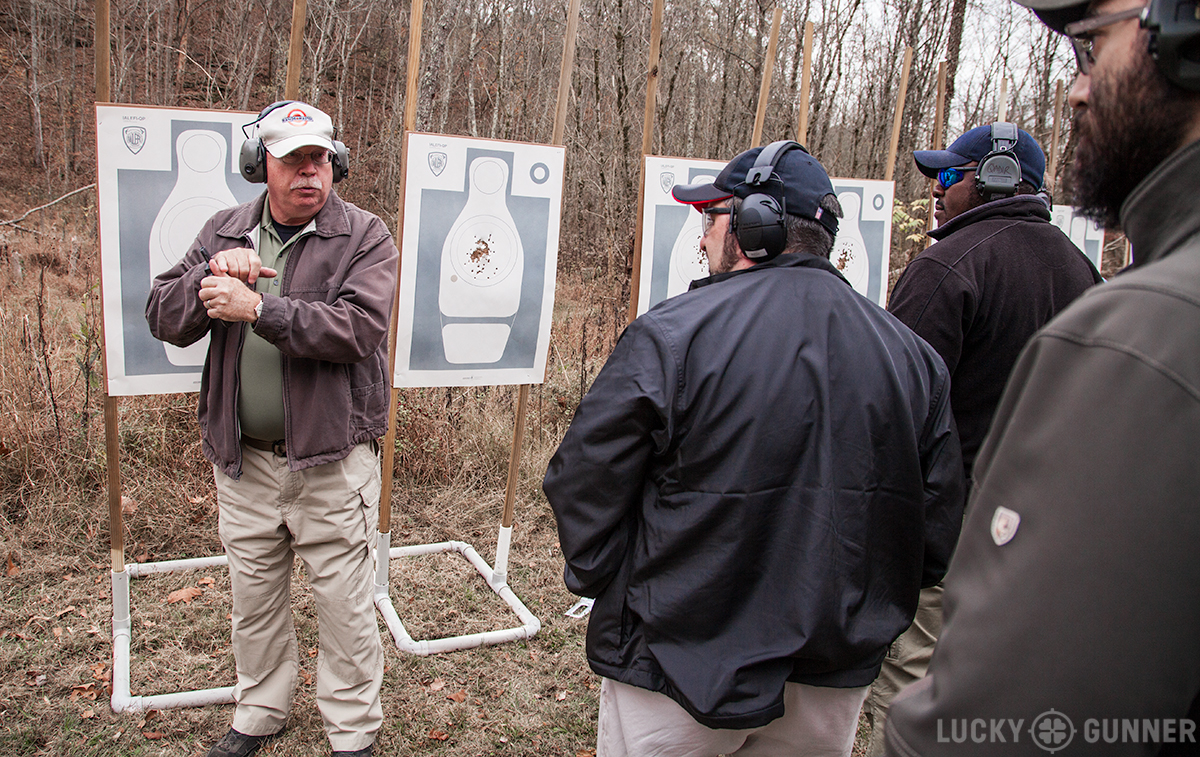
Now, Tom Givens and these other four instructors are all friends, and I’m not suggesting they’re at odds with each other. I just think there’s a lot we can learn from the different ways they’re approaching this topic. So let’s start by looking at some of the downsides of revolvers that Tom pointed out during his class.
First, there’s the low ammo capacity — five or six shots versus 13 to 16 in a compact 9mm. Reloads are a huge pain – they take forever and they’re really easy to mess up. And then there’s the malfunctions.
The way Tom puts it is that, “People who say revolvers never malfunction never shoot their revolvers.” And I couldn’t agree with that more.
It never ceases to amaze me just how many people are under the impression that revolvers are incapable of malfunctioning. You can just look at some of the comments on some of our other revolver videos and blog posts to see just how common that sentiment is.
The fact of the matter is that even though revolvers can be very reliable, they’re also prone to some pretty serious issues that don’t affect semi-autos. Just in the past year, had I’ve had plenty of revolvers malfunction on me and I’ve also seen people on the range have problems, too.
Problems like…
- A frozen cylinder from debris under the extractor star or from out of spec primers.
- An extractor rod backing itself out preventing the cylinder from opening.
- Multiple light primer strikes.
- A shooter being sprayed with bullet fragments from a revolver with severe timing issues.
- A Smith and Wesson revolver with a broken cylinder release latch.
- A Ruger GP100 that completely stopped working due to a broken cylinder latch.
- And several instances of triggers spontaneously dragging or freezing up for undetermined reasons.
- And I’m not even going to go through all the user-induced problems like short stroking the trigger or all the different ways you can fumble a reload.
Out of all those issues, only one — the light primer strikes — is easily fixed. You just pull the trigger again. All those other issues, you have to get out the toolbox, or at the very least spend a few minutes messing with the gun, and in some cases, even send it back to the factory.
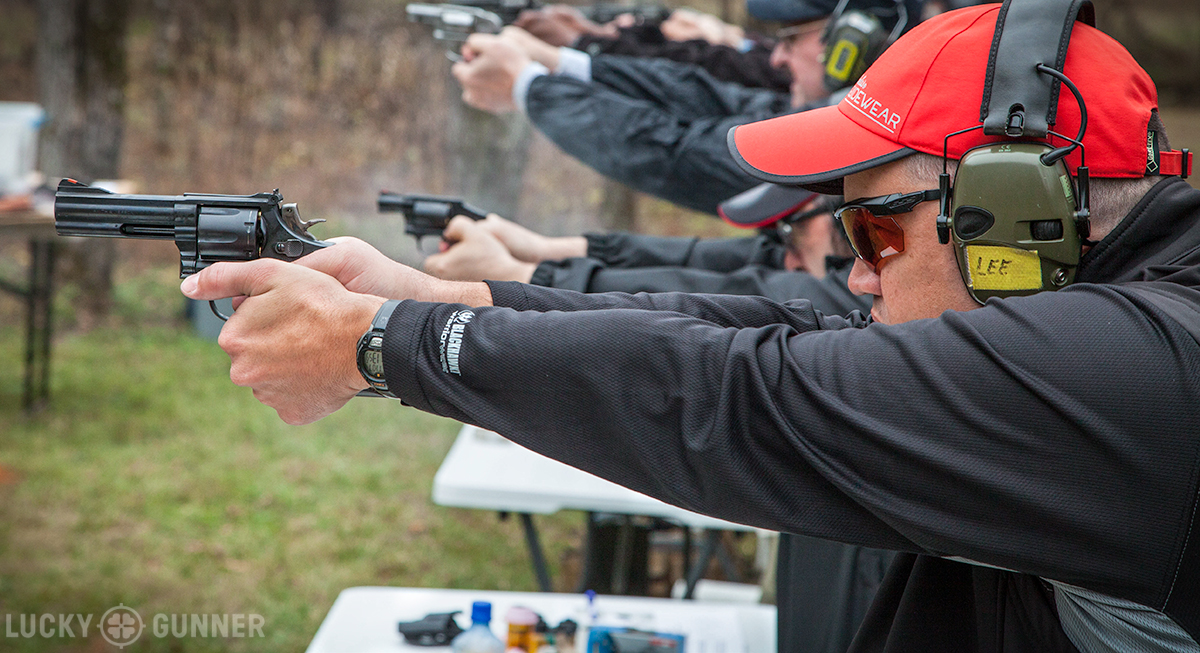
Of course, semi-autos malfunction too, but the most common problems can be fixed with a simple tap-rack drill that just takes a second. Double feed malfunctions take a little longer to fix, but they’re really not all that common with modern quality pistols using decent ammo.
Over the course of Tom’s one-day revolver class there were plenty of malfunctions on the firing line, and he was sure to point them out every time, emphasizing just how difficult it can be to fix them under pressure.
Overall, the students in that class were already pretty decent shooters but most of them hadn’t spent much time with revolvers before. At the end of the class, everybody’s shooting had improved, but it didn’t seem like anyone was in a hurry to trade in their favorite semi-auto carry gun for a revolver.
The previous month at the Revolver Roundup in Dallas, I don’t think any of the four instructors would have denied that there are some serious downsides to revolvers and we saw some issues with the guns in that class, too. But there was a bigger emphasis on some of the less-appreciated benefits of revolvers.
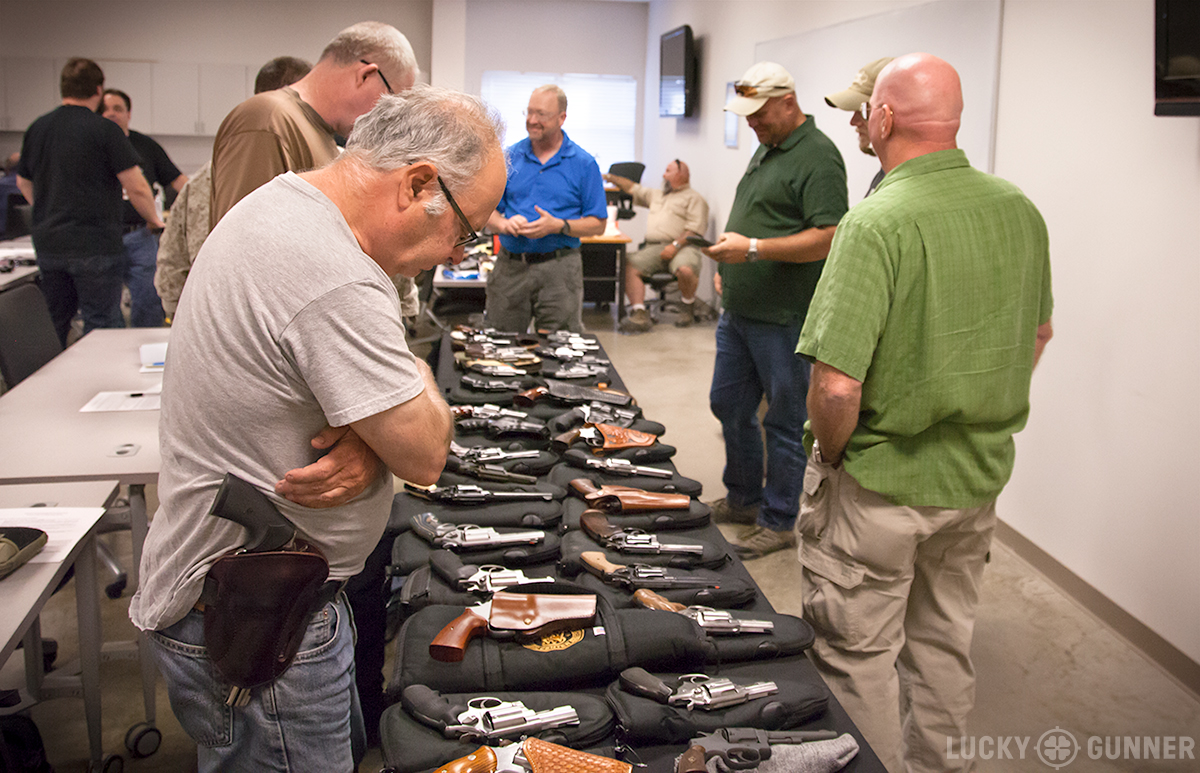
For example, at contact distance, revolvers are actually less failure prone than semi-autos. In a hand to hand struggle, you can get clothing and limbs in the way and all kinds of other problems that can stop a semi-auto that don’t usually affect a revolver. That’s one of the reasons they make such good backup guns.
In terms reliability in a broader context, I think Chuck Haggard really hit the nail on the head when he pointed out that semi-autos are more tolerant of abuse but revolvers are more tolerant of neglect. A modern full size 9mm pistol from a quality manufacturer should be expected to go through a 1000 round class in a weekend without any problems. If you try the same thing with a revolver, you’re probably going to run into some issues, especially if you don’t keep it clean.
But if you take that same 9mm, load it up, and stick it in a drawer or in a holster and don’t touch it for a few years, what are the chances it’s actually going to work if you suddenly need it some day? It might get through a whole magazine without a hiccup, but there are a lot of things that can go wrong if you don’t keep it lubricated and maintain it.

On the other hand, a neglected revolver — as long as it’s kept relatively dry, it’s probably going to work. It’s being used that usually gives revolvers problems.
I’m not suggesting it’s ever okay to neglect a self-defense gun. Ideally, you’ll be practicing with it, handling it, maintaining it, and keeping it in good working condition. But for the majority of gun owners out there, that’s just not reality. And this is where revolvers can start to make a whole lot of sense.
It’s easy to forget that most people who get a gun for personal protection very rarely go to the range. They have zero training and they don’t handle guns regularly.
The way Darryl Bolke put it is that “Revolvers are what 90% of armed people in the country should be carrying because most people can’t even do a chamber check on a Glock”.
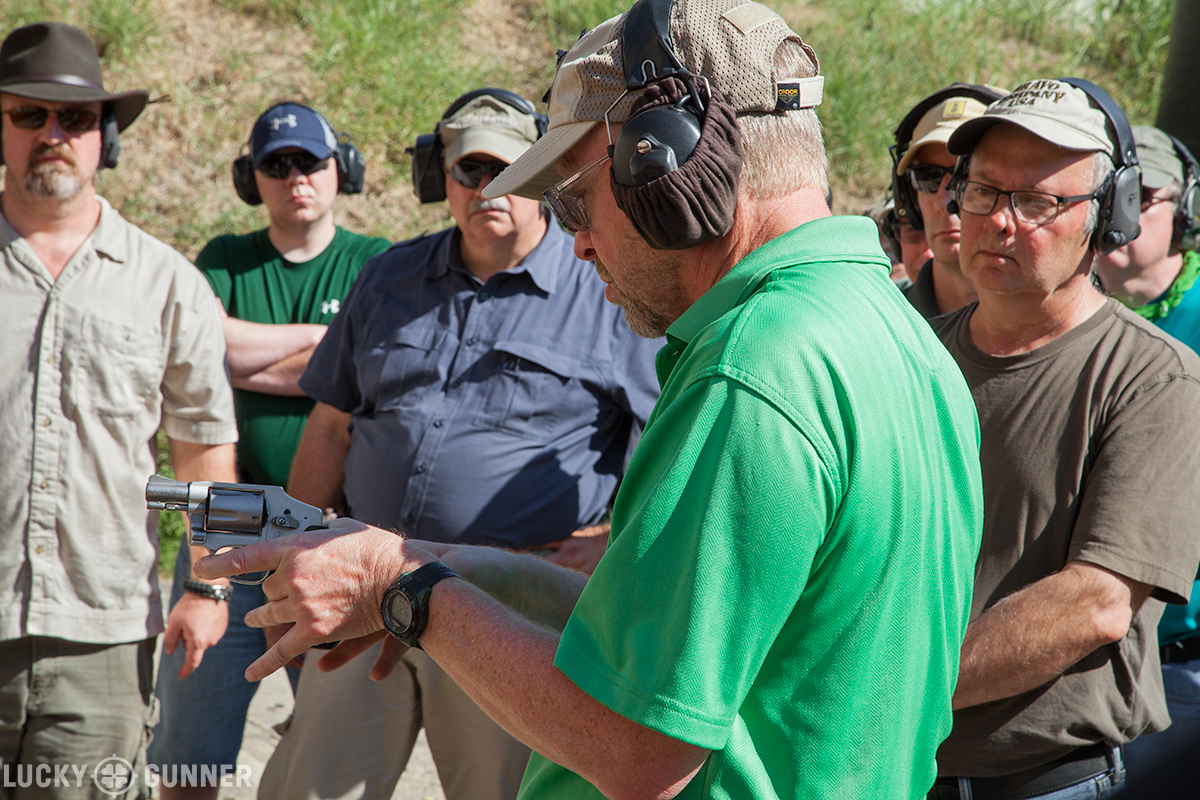
Even if more people were to take a decent training class after buying their first gun, what are the chances they’re going to remember how to load, unload, and safely handle that semi-auto if they’re not practicing with it? Anyone who has to put a lot of conscious thought into how to operate their pistol might be better off with a revolver where the controls are more intuitive and it’s harder to make a mistake.
For somebody who is serious about learning how to shoot — or even just somebody who enjoys it as a hobby or who seems to pick up on it quickly — for them, I’d say semi-auto all the way. But for the average person who wants to buy a gun and just stick it in the back of the sock drawer and forget about it, a revolver is very much worth considering, even with all of the drawbacks.
If you’re looking for any kind of firearms training (not just revolvers), I highly recommend seeking out any of the instructors mentioned in the video.
Hardwired Tactical classes are run by Darryl Bolke and Wayne Dobbs and the rest of their team in the Dallas area.
Claude Werner has an excellent blog and teaches classes near Atlanta, GA.
Chuck Haggard’s training schedule is available at Agile Training and Consulting.
Tom Givens of Rangemaster Firearms Training teaches classes all over the US.
There’s a decent probability that at least one of these guys is running a class in 2016 within a few hours’ drive of where you live, so quit making excuses and get some good training this year!
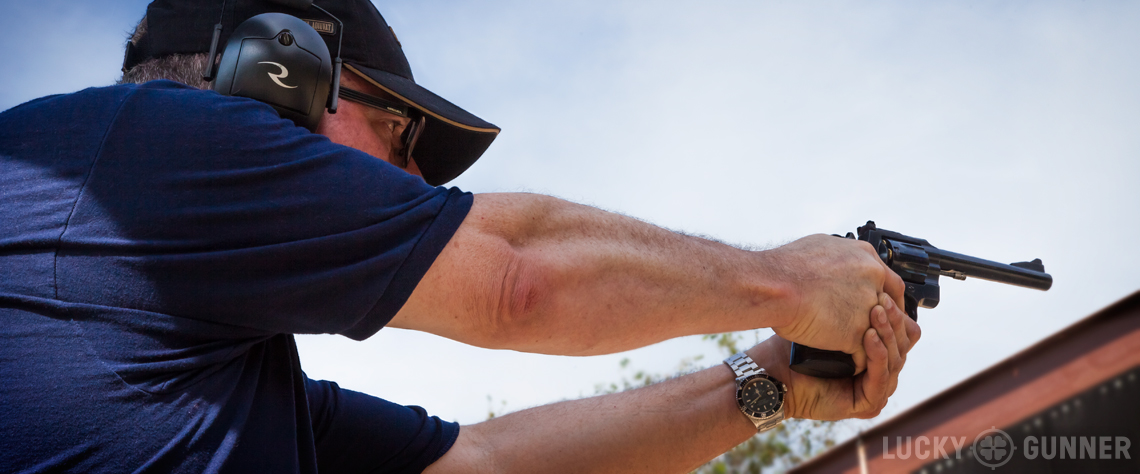

I strongly disagree with the reliability issue.
I have never in my life had a revolver fail to fire when I pulled the trigger. Not one single time.
Semi auto may fire a single time, but the ability to fire a second time is based on a large number of variables, none of which apply to a revolver.
By definition semi-autos are less reliable, because there are more things that can go wrong, and more things that need to go exactly right in order for the action to cycle properly.
The chance of need, in a domestic self-defense situation, of more than six rounds, is so remote as to be statistically zero.
People who want more capacity certainly may, but it’s not necessary.
A revolver can be reloaded as quickly as an automatic, if it is practiced, and nothing is effective without practice anyway.
I would stake my life on any revolver, especially the ones I own, but I would not stake my life on any semi automatic, not even the ones I own.
Then, respectfully, you haven’t seen enough revolvers being shot. I say this as a guy who carries a wheelgun daily.
I do not shoot as much as professionals, but I’ve probably put several thousand rounds through rugers, colts and smiths.
Never a Single misfire, never single problem at all, and if there is a misfire who cares just pull the trigger again, the cylinder will cycle and you have another round.
At the end of the day, we have to base our thoughts on our own experience.
My own experience is considerable and my revolvers have been perfect.
Also, i have never spoken to another human being who is ever had a problem with a revolver.
You may not have experienced any revolver failures but they do fail. I had a brand new Ruger Police Service Six lock up after about 50 rounds. The cylinder locked and would not open and had to be repaired by an gunsmith. I’ve had 2 ejector rods back out on Smith’s causing the cylinder to bind rendering it usless (now I own the tool to tighten the ejector rod). They are mechanical so they can fail.
I suppose it is possible for even a properly maintained revolver to fail, but in my experience it has never happened. I make sure all the screws are tight as part of the cleaning process after a shoot.
Semi automatics depend upon the cartridge to cycle the action, which means that every semi auto is literally only as reliable as the cartridge in the chamber at the time.
With a revolver, if there is a misfire, you just pull the trigger and the next round shoots.
I appreciate those who prefer semi autos, but if I have to stake my life on a shot, I will choose a revolver.
I too have a lot of experience with revolvers over many decades. My experience with failures were limited to:
1. Light hits due to action jobs. Obviously, these were at the range as I was working through whether action was too light: so it wasn’t a problem–the adjustments were made.
2. A Chiappa Rhino which was not ready for prime time.
3. A S&W Model 19 which started binding up when it got hot. (Obviously, that was discovered on the range, and there is a fix for such things.)
That is the sum total.
It all boils down to:
-take care of your guns
-practice
-carry a gun you’re comfortable with that’s accurate in your hands
The rest is academic.
A semi-auto is only easier to reload IF you are carrying an additional PRE-LOADED magazine. Many people are now carrying single stack 6 or 7 shot semis and no spare mags… not much of an advantage.
Very true. The whole “single stack frenzy” is counter-intuitive to the purpose of a concealed carry firearm. If you are only going to carry a gun with 6 or 7 rounds in it and no spare mag, you are much better off with a revolver. Not my philosophy as I always carry a G21 with an extra mag.
Great video. Definitely learned a lot, especially about revolver reliability. I’ve never had a FTF with my revolvers, but admit I’ve seldom put more than 100 rounds through one on any given day. The big thing to come out of this that I agree wholeheartedly with is that if someone is going to buy a gun and not shoot it regularly, then a revolver is a much better choice for them.
I’m starting to think that Lucky Gunner is populated by revolver haters. Even the wheel gun Wednesday articles are all tinged with this condescending attitude towards revolver aficionados.
The claims in this article are simply absurd. My favorite was the part about how revolver malfunctions often “in some cases, even send it back to the factory.” Yes, because the GUN WAS MANUFACTURED INCORRECTLY. If the cylinder latch on your GP100 is breaking, that’s a defect, friend. If the timing of your revolver is so off that it’s splitting bullets, it’s poor quality to being with or very old. The only time I’ve experienced that (including rentals) is with my grandfather’s old single action .22 on occasion.
A decent quality revolver that is given a modicum of care (brushing it off once in a while) will function reliably. If you’re shooting enough crappie ammo without cleaning to jam your star extractor, for example, you’re borderline criminally negligent. I’d like to see a semi auto function reliably with a similar level of abuse and neglect. And for the record, if you consider revolver reloads difficult, maybe buy some snap caps and practice. My gun – ambivalent wife figured left handed reloads at speed in about half an hour.
My issue is that there shouldn’t be this competition between gun types. Revolvers and semi autos are two totally different things and are equally valid. This kind of gear elitism is rampant in the semiauto crowd and it’s beyond pointless. It’s like trying to say a sports car is better than a truck: a useless comparison of two totally different things with different strengths. The semiauto elitists need to get it in their heads that revolvers offer advantaged just like semiautos do to both novice and experienced gun owners.
Sean, I’m sorry you’ve gotten that impression from the revolver articles. Personally, I am a huge fan of revolvers, but I also believe they have severe limitations that are often overlooked by other revolver enthusiasts. I agree that semi-autos and revolvers each have different strengths, but the mission for both is the same — to shoot bad guys. In that respect, I think it’s appropriate to compare the two systems to determine in which contexts they are better suited for that task.
I like your articles, and I don’t believe you re being condescending, but I also don’t believe that revolver enthusiasts “overlook” the limitations. They just don’t find them compelling in their personal situations.
I carried revolvers made by Colt, Smith and Wesson, and Ruger as primary and/or backup weapons throughout a 30+-year LE career, some of it as an instructor. I also shot in a few PPC matches with them. I’ve seen a lot of revolver bullets go downrange, but I never saw most of the malfunctions mentioned here. I did see a couple of guns tied up by backed-out ejector rods, and one stainless Ruger locked up due to lubrication issues. (The fact that it happened during an outdoor qualification in 20-below-zero weather might have had something to do with it. I’m not exaggerating about the temperature; I’ve never been so cold.) I also once had to tell an agent to get his Smith revolver repaired; the cylinder latch had fallen off and he was opening the cylinder by pushing the stud the latch screws into.
I also think that the chances of the average civilian carrier getting into a fight that requires firing more than 5 or 6 rounds are almost infinitesimal, and a revolver would serve most people very well.
That said, I don’t think a person carrying a 1911 or a 10-plus-round 9mm is overgunned or paranoid. If you have to shoot someone, you’ve already beat the odds (in the worst possible way); who’s to say how many rounds you’ll need?
End times scenario – revolver with proper maintenance.
Good article (and video). As expected, the opinions of presenters draw the opinions of viewers, but overall, there’s plenty of good take-away material from this one.
When you take time to consider objections instead of trying to denounce them, you can learn a lot.
I enjoy revolvers…I enjoy semi-automatic pistols…I am not a snob. If it goes down range— I try to put it in the center of said target.
You snobs/secular armourists…get over it…and figure out your best defense. Revolver?>>>.Good ! Semi-auto?>>Good !
Are they commin’ at cha’? Well…dumbass…fire the revolver or the semi-auto at them. Simple.
Revolvers are a conundrum. We often hear, “Revolvers are for beginners.” Or, “A snub-nose revolver is an expert’s gun.” Which is it? Well, both. I have seen people try to load a magazine with the bullets facing backward. Then after they have been shown how to properly load a magazine, they still try to insert the magazine in the semi-auto backward. For those people, a revolver is best. It’s simply not realistic to think that most people will train as enthusiasts do. Unfortunately, the majority of people who buy a gun for home defense want to throw it in the sock drawer, and call it good. Just as most drivers want to just put gas in their cars and call it good. Only a very low percentage of drivers want to learn how to change a serpentine belt or practice high-speed emergency lane-change maneuvers and J-turns. That’s fine. And most of the time it works well enough, especially considering how many cars there are in the US.
As to reliability, revolvers are Mac operating systems and autoloaders are Windows. Mac computers don’t crash very often, but when they do, they crash hard. I’ve had exactly 4 revolvers malfunction, and one of those was my fault for installing springs that were way too light. On the other hand, I’ve had some autos (mainly 1911s) malfunction so much I felt like a Skinner rat with OCD tapping and racking until I dropped. I’ve also had more than one auto loader just plain break. A gun is just a machine. Machines break. That’s life. It depends on what you need to do with your machine. I could throw a Glock on the sidewalk, and it will probably work just fine. A Colt Python? Not so much. If you need to throw your gun around a lot, get a Glock. If you need a tack driver with an action like butter, get a Python.
Wow! I am a firearms instructor with emphasis on concealed carry. I have been a police officer, gone thru three police academies. I have never, before reading this article, heard any one criticize revolvers like the guys in this article did. Their complaints about revolvers, for all practical purposes, have been totally none existent in my 40 years of shooting experience. I cannot remember ever seeing a revolver fail when going thru firearms training at the police academies, but there were always failures with a few of the autos. Almost all those failures were due to cheap “practice ” ammo and would not have happened with “factory self defense”ammo. But the story is, that ammo would have functioned in a revolver. The “problems” pointed out against the revolvers were problems that should have been identified much earlier with practice because they are mostly manufacturing problems. The biggest problem is people do not practice with the firearm they plan to carry for protection. When someone points a gun at you or pulls a knife on you and you believe your life is about to end, you better know what you are going to do, how you are going to do it and do it flawlessly under more stress and fear than you have ever experienced in your entire life! Just getting the handgun into action will be a very difficult task….if you have not practiced that action at least a hundred times.
Those were my thoughts, In the thousands of rounds I have put through My glock and S&W model 10 since I got them a couple years ago, I have never had major malfunctions like he was saying. Any problems I did have were ammo related. I had a single bad box of Aquila ammo, and my glock doesnt care for brown bear ammo but loves wolf steel cased and Cheap Aquila. And my Model 10 has had 5 or 6 dead primers and all but one of those went off with a second strike. The ammo was hand loaded by me and only intended for the range since the primers got a little bit of oil on them.
All of those revolver problems for the most part are in revolvers that have been severely damaged, manufactured wrong, or had the hell shot out of them.
Same here, and I almost exclusively shoot revolvers. Only problem I’ve had was a bad round or two. I know light strikes can happen, but from my experience, those are usually either caused by a poor trigger job, or from using eastern bloc ammo with hard primers. In all my years, I’ve never seen any of the issues the author spoke of. Some of them, I can’t even imagine being possible unless they were caused by poor attempts at home gunsmithing, or extreme abuse.
I got my concealed pistol license using a full size 9 mm semi auto, and although it worked well most of the time, it did jam up three times during the weekend. Maybe being a new gun may have had something to do with it. Over all, I consider wheel guns more reliable because of fewer moving parts and less likelihood of mis-feeds jamming it.
One big issue I haven’t heard anyone mention is that I find that there are days when my arthritis won’t let me rack the slide on a semi-auto. So if I want to carry one for defense purposes, I would have to keep a cartridge in the chamber, and many of those guns don’t have safeties. My arthritis has never interfered with a revolver.
Agreed. The down side is that revolvers tend to recoil more (since the cycling of a semi-auto absorbs some of the energy), but Mag-na-porting and good grips can fix that.
Check out the EAA Pavona line. Those pistols were marketed towards women and the slide rack more easily. Snazzy colors too.
https://uploads.disquscdn.com/images/f9f45d0fefd181bcddc0ea3794b8dfb279ac689356341811997fa65b60a31fb4.jpg
Other than the objections already lodged about the revolver failure to fire being grossly overstated, I would only add one quibble: there are revolvers that hold 7 or even 8 rounds–so the choice is not just between 5 or 6 rounds.
I have both types of handguns, and I love both types. They each have unique, valuable advantages absent in the other. I would never give up either.
Chris makes a lot of valid points regarding revolvers. I’m a big revolver fan but I’ve seen revolvers jam up and fail just as Chris has. I’ve seen out of spec primers on factory ammunition bind up the revolver’s cylinder. Myself personally, I had some much burnt power/debris built up under extractor star that bound my cylinder up tighter than a drum. I’ve also short stroke extracting my empty brass which really caused problems with the brass getting caught under the extractor star. Fortunately this was only at a bowling pin shoot so it only cost me a slow time and not my life. So revolver’s also have their share of issues.
Revolvers also have their benefits. Every new shooter I’ve taken to the range has gravitated towards shooting my revolvers! The simplicity manual of arms favors the revolver. Many new shooters are intimidated by semi auto. Either by flying brass, racking the slide, trying to reload a magazine, or more complicated manual of arms on some semi.
They each have there advantages and disadvantages. Point is, people need to practice more regardless of which platform they use or prefer.
I thought Chris was fair and objective in his comparisons.
As with anything, failures will occur. It’s your conditioning or training that makes the difference in how you come back from those failures.
Number one . . . who lets their gun sit around for months or years without touching it?
Number two . . . if you have a gun like a Glock, it will pretty much always work. Period.
We own A revolver because I wanted my wife to know how they shoot and to be able to use one. It’s a weapon familiarization thing. And in the time we have shot it, it has never failed. My first handgun was a revolver. I like them. Every good shooter should be able to pick up any gun and shoot it. SFQA had a selection where we were given a selection of obscure guns and expected within a very short period of time to be able to shoot any of them proficiently.
But, in the end, no revolver can give you the advantages of a reliable pistol. I will live and die by my Glock 21 and my Jericho 9mm.
I have and still own all sorts of guns. My first handgun was a Ruger Stainless Security Six .357. Wonderful gun. Sold it to a friend of mine who was a smoke jumper so he’d have a powerful gun to take when he jumped into back country fires.
Because of the kind of work i do and what I prefer, I carry a Glock 21, but I always own at least one revolver at any given time. We keep guns around the house so we’re never far from one, although I usually carry at home. The one in our kitchen is a nice .38 Special with a couple of speed loaders handy. The rest are autos.
I think the author kind of went over the top dissing revolvers in this article, but no matter. Each to his own, and at the end of the day it doesn’t change my paycheck or my opinion of revolvers.
I agree with the story 100% at our home I have a 1911 that I use as my home defense gun. But for my wife who only cares about what gun is available for home defense when I have to work a set of night shifts. She has a revolver, I asked before my last run. ” Were is your gun?” She knew were it was and it is accessible for her. Then she asked… ” How do I shoot it again?” arrrrrggggg… If I get her out to the range out back once in a year, I have done good. So her question was not a surprise. It is what it is.. My two minute refresher consisted of. The gun is loaded, Point it at the bad guy and pull the trigger. Pull three times. If the threat has stopped. Look for another threat. Here is how to reload. Show me you can reload it please.
Done.
For her a revolver is the only logical choice. Sure I could just have a semi auto set up and ready to fire. but she would grab it and look at it wondering what to do. The revolver she can completely comprehend what suppose to happen.
Not optimal by any means, but like I said. it is what it is. She has a chance.
That’s too bad. My wife and i go to the range every week. When I’m not home she always carries her Beretta 92 with her and she is very capable with it.
Let’s continue this train of thought…..that a fifteen round semi auto is inadequate because ….if you are attacked by fifty or more bad guys………get my drift?
I wore the badge for 20 years and saw very very few of these complaints.
The most common scenario these days is a road rage incident…..six rounds of .357 is a pretty good problem solver.
I have heard the statement many times that a revolver gives trouble during a weekend class, shooting 1000 rounds. I cannot think of a self defense situation where I would need to fire 1000 rounds.
The statement that dirt under the extractor can tie up as revolver is true. If there is dirt under the extractor, the cylinder will not close, or close with difficulty. The shooter immediately knows that something is wrong and they can correct it before I carry my revolver outside into the world. When ejecting spent cartridges, during a reload, unburnt power can get under the extractor and prevent the gun from firing. The question to ask is, how often does a revolver need to be reloaded during a self defense situation?
I feel the proper way to judge revolver reliability would be to measure how often a revolver fails to perform on the first cylinderful of ammo. This testing should be done under self defense type conditions, not a relaxed test on the range.
I just discovered your site. I was excited about “wheel gun Wednesdays” and read several articles back to back. Unfortunately – you dont have a single pro revolver article that I can find. At the end of the day they all pretty much just outright dismiss revolvers as a viable SD tool. Maybe you should just re-name the articles “semi-auto’s preferred Monday – Sunday” or something? To each his own and we all do what we feel we must but I personally dont need a 15 round 9mm with 4 spare mags to go to the grocery store. And for what its worth – I’ve shot guns for over 20 years – own both semi’s and revolvers – I’ve had 1 revolver stoppage in all those years…but every semi I own / owned has had a stoppage of some sort at one time or another. Its just a fact, whether its ammo related or limp wristing, or worn out springs, or a bad extractor or a bad magazine – you’re semi auto WILL hang up. Its not an opinion – its a fact. Hope its not when you need it most.
I’m sorry you were disappointed by the revolver series. It’s true that I never did an explicit “revolvers are the best” kind of article, but I also don’t recall ever dismissing revolvers as a viable self-defense tool. I do think the advantages of modern quality semi-autos make it difficult to argue for revolvers as being objectively better, but they certainly have their place, and I did my best to explore that nuance in detail in our series.
As far as reliability, I’ve seen dependable and malfunction-prone samples of both revolvers and semi-autos. If you’re particular gun is reliable and well-maintained, it doesn’t matter much whether it feeds from a cylinder or a magazine. But you still have to be aware of what can potentially go wrong with it, which problems can be easily fixed mid-fight, and which kind of problems turn your gun into an instant paperweight.
What I object to is that too many revolver fans are convinced that their gun is incapable of malfunctioning, despite whether it’s poorly maintained or fed garbage ammo. And on the other end, many shooters who have barely picked up a revolver are quick to dismiss them as “outdated” without really understanding why. The fact that these mindsets are so pervasive in the shooting community is proof to me that very few really understand these guns — either the good or the bad, and that is why I did the “Wheel Gun Wednesdays” series.
Nothing finicky about the way a revolver digests its ammo, where auto pistols rely on perfectly assembled ammo to run 110%.
Hey Chris,
A very interesting article. Thanks.
I also followed some of the discussions in the comments, and they too were very interesting.
What I think is missing, both in the article and in the comments, is a consideration of the revolver in the role of a pocket gun. As far as I can tell, small revolvers have some distinct advantages in that role. For instance: they conceal really well due to their curved outline, they are relatively easy to grab and draw fast from a pocket (I tried a S&W 649-2 vs. a Glock 43, and there was just no comparison), they are very safe (call me paranoid, but a chambered, pre-cocked, striker-fired gun in my pocket makes me nervous), and they have no magic button that can be accidentally pressed inside a pocket, leaving you with just 1 round in your gun.
Also, as far as I know, the #1 advantage of semi-autos, capacity, is greatly diminished when we limit the discussion to models that are as concealable or pocketable as a S&W J frame or a Ruger LCR. (A pocketable 9mm semi-auto may still hold 40% more rounds than a J frame–7 vs. 5–but it’s no longer the 15 vs. 5 or 6 that you get with bigger carry guns.)
I’ll be glad to know what you think about these points. Also, can you point out a semi-auto 9mm, preferably a true DA or DA/SA, that will be better as a pocket gun than a S&W J frame or a Ruger LCR?